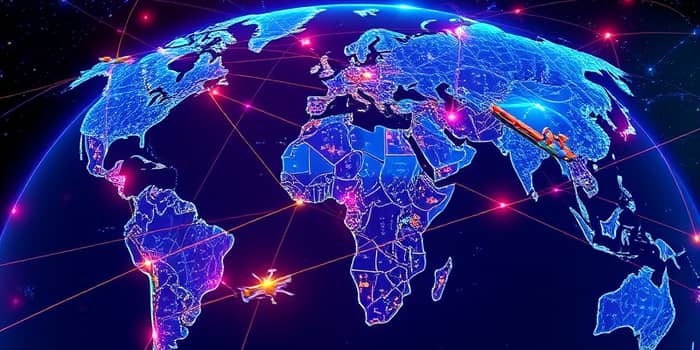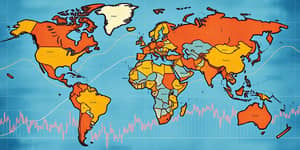As global markets evolve, the nexus between technology and commerce reshapes the way nations exchange goods and services. Digital innovation is no longer a luxury—it’s the beating heart of modern trade, demanding adaptability and vision from businesses, policymakers, and communities worldwide.
Global Trade in Transition
In the first half of 2025, global trade expanded by $300 billion in H1 2025, with a remarkable 14% surge in U.S. imports and a 6% jump in EU exports. While volumes grew by just 1%, rising prices drove much of the value increase, underscoring the volatility of commodity markets and inflationary pressures.
Developed economies led growth this year, reversing recent trends, while Africa’s intra-regional trade stood out with a 16% rise. Services trade remains a key driver, expanding 9% year-on-year and reflecting the growing importance of digital offerings in the global economy.
Digital Transformation Driving Growth
The digital transformation market, valued at $535 billion in 2022, is on track to exceed $3.4 trillion in value by 2032, with a CAGR of 20.8%. Cloud technology adoption has reached 92% among global business leaders, and nine out of ten companies now use digital tools to optimize supply chains.
Today, approximately 15% of global GDP—around $16 trillion out of $108 trillion—is generated by digital activities, highlighting the rising significance of e-commerce platforms, trade portals, and automated customs systems.
- AI-powered predictive analytics for risk mitigation
- Blockchain-based documentation and verification
- Internet of Things tracking and logistics insight
- Cloud infrastructure enabling borderless scalability
- Customs automation and electronic trade documents
Disruptive Technologies Transforming Trade
Leading technologies such as AI, IoT, and blockchain are revolutionizing every stage of the trade lifecycle. Predictive analytics enhance demand forecasting, while blockchain enables paperless, end-to-end trade processes that cut costs and speed up border transactions.
IoT sensors track goods in real time, ensuring transparency and reducing losses. In Asia, semiconductor and high-tech product exports have become the core engine of growth, driven by state-backed investments and robust digital policies.
Policy and Regulatory Landscape
As digital trade barriers evolve, policymakers grapple with data localization rules, privacy regulations, and digital taxation regimes. The ongoing WTO e-commerce moratorium debate illustrates the tension between traditional customs duties and modern digital flows.
- Balancing data sovereignty with cross-border flows
- Crafting interoperable digital trade standards
- Addressing privacy, cybersecurity, and IP concerns
International cooperation is essential to harmonize regulations and ensure equitable access for developing economies lacking robust digital infrastructure and skilled workforces.
Regional Insights
North America commands 42% of the global digital transformation market, underpinned by widespread connectivity and digital payment adoption. The Asia-Pacific region, bolstered by $620 billion in 2022 FDI, leads in growth rates and technological deployment.
Europe enjoys solid gains with EU exports up 4.7% in Q2 2025, driven by Germany, France, and Italy. Africa’s resilience is notable: intra-regional trade rose 16% year-on-year, showcasing the promise of digital corridors in emerging markets.
Challenges and Opportunities Ahead
While digitalization offers resilience and efficiency, it also poses challenges. Geopolitical tensions, policy uncertainty, and digital protectionism threaten the free flow of data and innovation. SMEs, despite benefiting from lower entry barriers, still face disparities in infrastructure and digital literacy.
To succeed, businesses must embrace real-time supply chain visibility, invest in workforce upskilling, and champion sustainable and inclusive practices. Digital tools can power greener logistics and democratize market access for small firms.
Future Outlook: Trends to Watch
The next decade will witness accelerated automation across the trade lifecycle and deeper integration of AI for logistics optimization. Blockchain platforms will scale further, enabling secure, transparent transactions on a global scale.
- Accelerated automation across operations
- Expanded AI for logistics optimization
- Blockchain trade platforms scaling globally
- Data-driven green and sustainable routes
- Regulatory harmonization for digital trade
Key Figures and Data Points (2025)
As the contours of global trade continue to shift, digitalization and disruption offer both promise and peril. Stakeholders who embrace innovation, foster collaboration, and champion inclusive, sustainable practices will shape a future where trade becomes more resilient, transparent, and equitable for all.
References
- https://www.crescendoworldwide.com/blogs/digital-transformation-in-international-trade
- https://unctad.org/news/global-trade-grew-300-billion-first-half-2025-led-us-imports-and-eu-exports
- https://www.idc-a.org/insights/qUi9XgvyrzSkyDUy9Tqr
- https://scoop.market.us/digital-transformation-statistics/
- https://openknowledge.worldbank.org/entities/publication/1fad03ce-dd89-4910-b127-f0b4aa05817e
- https://www.oecd.org/en/data/insights/statistical-releases/2025/08/international-trade-statistics-trends-in-second-quarter-2025.html










